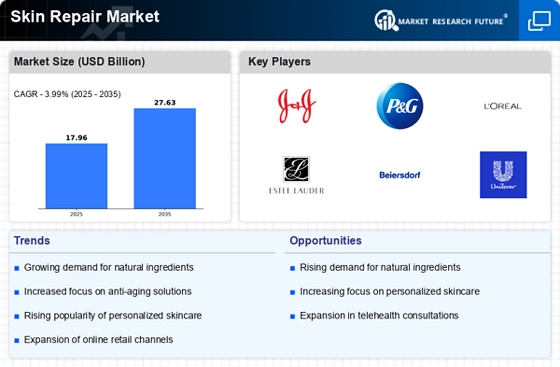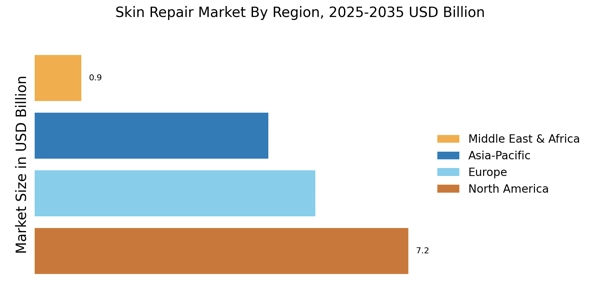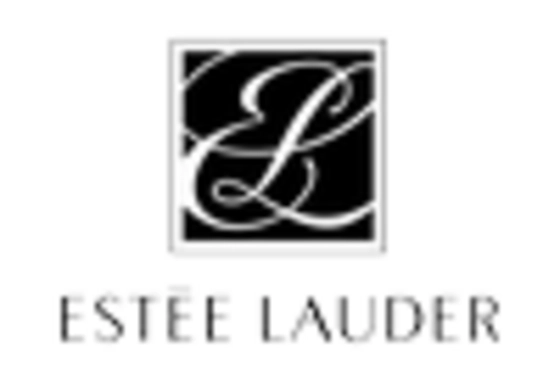North America : Market Leader in Skin Repair Market
North America is the largest market for skin repair products, holding approximately 40% of the global market share. The region's growth is driven by increasing consumer awareness regarding skin health, coupled with a rise in skin-related issues. Regulatory support from agencies like the FDA ensures product safety and efficacy, further boosting consumer confidence. The demand for natural and organic products is also on the rise, reflecting a shift towards healthier lifestyle choices.
The United States is the leading country in this region, with major players like Johnson & Johnson, Procter & Gamble, and Estée Lauder dominating the market. Canada follows as the second-largest market, contributing around 10% to the overall share. The competitive landscape is characterized by continuous innovation and marketing strategies aimed at enhancing brand loyalty. Key players are increasingly focusing on e-commerce platforms to reach a broader audience, adapting to changing consumer behaviors.
Europe : Emerging Trends in Skin Care
Europe is witnessing significant growth in the skin repair market, accounting for approximately 30% of the global share. The region's demand is driven by a growing aging population and increasing awareness of skin health. Regulatory frameworks, such as the EU Cosmetics Regulation, ensure high safety standards, which enhances consumer trust. The trend towards sustainable and eco-friendly products is also gaining momentum, influencing purchasing decisions across various demographics.
Leading countries in Europe include Germany, France, and the UK, with Germany being the largest market, contributing around 12% to the global share. The competitive landscape is marked by the presence of established brands like L'Oreal, Beiersdorf, and Unilever. These companies are investing in research and development to innovate and expand their product lines, catering to diverse consumer needs. The rise of online retail channels is also reshaping the market dynamics, making products more accessible to consumers.
Asia-Pacific : Rapid Growth in Emerging Markets
The Asia-Pacific region is rapidly emerging as a significant player in the skin repair market, holding approximately 25% of the global share. The growth is fueled by rising disposable incomes, urbanization, and increasing awareness of skincare among consumers. Countries like China and India are witnessing a surge in demand for skin repair products, driven by a youthful population and changing lifestyle habits. Regulatory bodies are also becoming more stringent, ensuring product safety and quality, which is vital for market growth.
China is the largest market in this region, contributing around 15% to the global share, followed by Japan and India. The competitive landscape is characterized by a mix of local and international brands, with key players like CeraVe and Neutrogena making significant inroads. The market is also seeing a rise in e-commerce platforms, which are becoming essential for reaching tech-savvy consumers. Companies are focusing on localized marketing strategies to cater to diverse consumer preferences across the region.
Middle East and Africa : Untapped Potential in Skin Care
The Middle East and Africa (MEA) region is gradually emerging in the skin repair market, currently holding about 5% of the global share. The growth is driven by increasing urbanization, rising disposable incomes, and a growing awareness of skincare among consumers. Regulatory frameworks are evolving, with governments focusing on enhancing product safety and quality standards, which is crucial for market expansion. The demand for premium and luxury skincare products is also on the rise, reflecting changing consumer preferences.
Leading countries in this region include the UAE and South Africa, with the UAE being the largest market, contributing around 3% to the global share. The competitive landscape is characterized by a mix of local and international brands, with key players like Avène and La Roche-Posay gaining traction. The market is witnessing an increase in online retail channels, which are becoming essential for reaching a broader audience and catering to the growing demand for skincare products.


















Leave a Comment